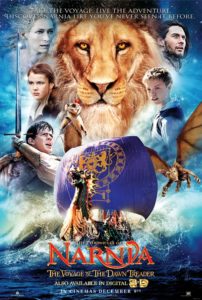 After recently rewatching the other two Narnia movies[1], I have now proceeded to watch for the first time The Voyage of the Dawn Treader. This was one of young me’s favorite books, in retrospect because of how it involves episodic exploration of unknown parts in which random events occur. Examples: captured for slavery! found invisible monsters with weird tracks! cursed dragon hoard!
After recently rewatching the other two Narnia movies[1], I have now proceeded to watch for the first time The Voyage of the Dawn Treader. This was one of young me’s favorite books, in retrospect because of how it involves episodic exploration of unknown parts in which random events occur. Examples: captured for slavery! found invisible monsters with weird tracks! cursed dragon hoard!
And I guess what I think is, without a cohesive throughline, that’s a bad look for a movie? Because “we’re sailing to the edge of the world and also looking for some lords who went this way before, because of some plot thing or other with green mist that frankly none of us[2] can be bothered to really remember well” is not a cohesive throughline. But it’s a perfect long-form episodic throughline, where you talk about the so-called main plot for maybe five minutes every other episode but mainly focus on the island of the week.
As far as the nuts and bolts of the movie… Aslan: mainly around to tell Lucy she should like herself for herself instead of wanting to be glamorous and older, and to take all the credit for making Eustace[3] a better person, even though let’s be real, it was finally having a friend that turned him around. Because Reepicheep is the best mouse, is what. But despite an interlude about heaven and who deserves to be there and when, the Christian trappings of this movie were… no, I’m doing this wrong. Christian trappings were all over the place, but at the expense of any actually useful Jesus values like forgiveness and loving your neighbor.
Ugh. Christian trappings. Goddammit.[4]
[1] They’re… not great. Like, my reviews might speak well of them? My counterpoint is “seeing this book for the first time on a screen” is its own special thing that takes away from noticing that it’s still only okay. And here I refer only to the first one. The second one is nowhere near as good as that.
[2] Okay, maybe me more than them. I would normally here say, well, maybe I was just too busy with work to pay attention. But I watch really a lot of TV and a good number of movies while working, and actually keeping up with the main plot has never been a problem before. So there’s a decent chance that the lack of new sequel was for a good reason.
[3] Eustace is a Pevensie cousin who is a right twit, until later when he is improved by the power of Narnia. If Aslan wanted to teach a Pevensie a lesson, it should have been teaching Edmund that, you know what, you were a right twit once upon a time too, so maybe cut a bro some slack? But CS Lewis is more offended by girls who want to use make-up and date than he is by toxic masculinity, and so here we are.
[4] get it?
 So, I got HBOMax, finally. This is good, as there are a pile of shows I want to watch, and bad, as where will I find the time? But the tipping point, of course, was the release of
So, I got HBOMax, finally. This is good, as there are a pile of shows I want to watch, and bad, as where will I find the time? But the tipping point, of course, was the release of  It’s not uncanny valley levels of weird, but it is nevertheless weird to see digital animation versions of real actors that you are already very familiar with. To wit, Cal Kestis, who is played by the Joker from Gotham and one of the Gallagher kids on Shameless. And he’s, like, just extremely recognizable, both character and voice. And in
It’s not uncanny valley levels of weird, but it is nevertheless weird to see digital animation versions of real actors that you are already very familiar with. To wit, Cal Kestis, who is played by the Joker from Gotham and one of the Gallagher kids on Shameless. And he’s, like, just extremely recognizable, both character and voice. And in 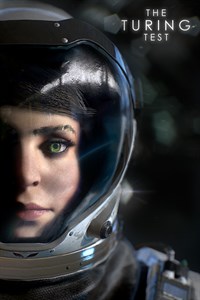 Because I am extremely timely, have another review of a game that’s leaving Game Pass today!
Because I am extremely timely, have another review of a game that’s leaving Game Pass today! 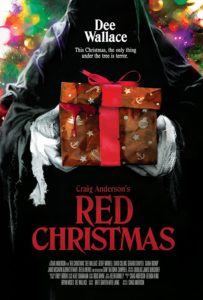 Red Christmas
Red Christmas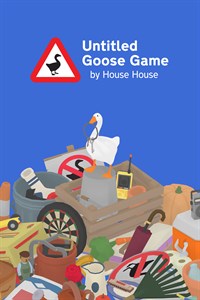 I’ve been vaguely aware of
I’ve been vaguely aware of 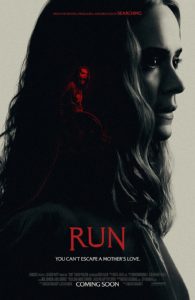 Hulu
Hulu 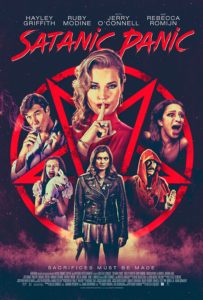 I’m going to cut straight to the chase here: what Home Alone did for burglars,
I’m going to cut straight to the chase here: what Home Alone did for burglars, 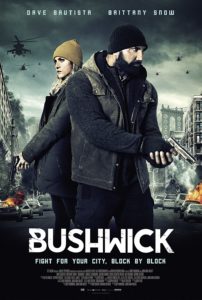 I’ve been to New York City once, in the late ’90s before things got “cleaned up”, whatever that means. So I saw Central Park when it was scary, and based on the looks I got in my giant cloak, apparently I was the scary person in the park. Which is okay. And I saw all the peepshow spots on what I have to assume some 20 years later was 42nd Street. The posters in the windows say “a quarter”, but you cannot get into those places for a quarter. Which is false advertising, but “cleaning them up” for false advertising seems a little harsh. About the only other thing I did was, because I was young and foolish, go to the Hard Rock Café. I’m cooler now than I was then, in most ways.
I’ve been to New York City once, in the late ’90s before things got “cleaned up”, whatever that means. So I saw Central Park when it was scary, and based on the looks I got in my giant cloak, apparently I was the scary person in the park. Which is okay. And I saw all the peepshow spots on what I have to assume some 20 years later was 42nd Street. The posters in the windows say “a quarter”, but you cannot get into those places for a quarter. Which is false advertising, but “cleaning them up” for false advertising seems a little harsh. About the only other thing I did was, because I was young and foolish, go to the Hard Rock Café. I’m cooler now than I was then, in most ways.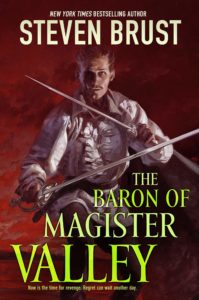 It has taken me over three months to read
It has taken me over three months to read